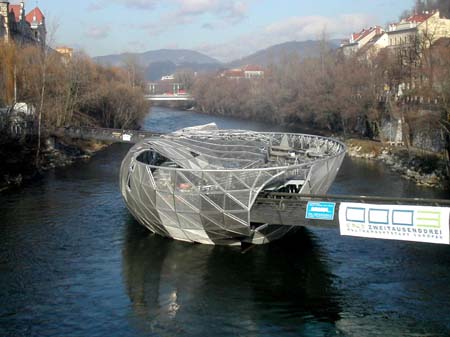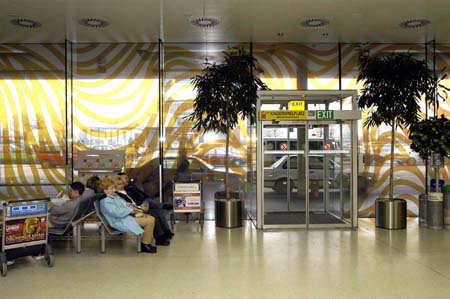GRAZ
PLACEText: Christina Merl
Do you know Graz? No, never heard of? Well, I think I should tell you a few details about “Europe’s Capital of Culture” in 2003 then. For those who don’t know it – the title is an annual award from the European Union aimed at highlighting the EU’s many and varied cultures (and probably boosting tourist numbers…).
Graz is the first Austrian city that has been chosen as Cultural Capital of Europe by the ministers of culture of the fifteen EU member countries. The honour coincides with the 875th anniversary of Austria’s second-largest city and results in a unique cultural programme of more than 5,000 events.

Murinsel: Elvira Klamminger: A multicultural island arena was set up on River Mur according to plans by the New York artist and designer Vito Acconci, offering a cafe and rooms for events and performances.
Sometimes referred to as Austria’s “hidden gem”, the provincial capital of Styria has long lived in the shadow of more famous Austrian towns such as Salzburg or Innsbruck. However, Austria’s “gateway” to the southeast of Europe has been gearing up over the past twelve months to get the title of “Europe’s Capital of Culture” in 2003, following Salamanca (Spain) and Bruges (Belgium). Certainly, authorities and tourist boards in Graz hope that the rest of the world will soon discover the charms of their city and that it will be on the tourist map in the future.

Airport: Harry Schiffer: A newly designed airport welcomes passengers in Graz.
I think you can best discover Graz by walking around. The old, pedestrianised medieval city centre is one of the best preserved city centres in central Europe and was declared cultural world heritage by the Unesco in 1999. It offers you romantic narrow streets and Italian-style palazzi with southern flair. Graz is many things at the same time, you know – a Gothic double-spiral staircase; a fortification that was never conquered but blown up; a chateau with 365 windows; a clock tower that’s got time the “wrong way round” etc. However, Graz is far from being a “museum”. Quite the contrary – at weekends the narrow streets are bustling and at the first hint of sunshine, everyone herds for the numerous outdoor cafe and restaurants. One fifth of its 250,000 inhabitants being students, Graz is a well-known university city and hosts avant guard arts and jazz festivals as well as classical concerts and operas throughout the year.

Hand-Out: Harry Schiffer: Drivers approaching Graz are welcomed by artifical plastic arms.
As well as bringing recognition, becoming a European Capital of Culture also means plenty of renovation. Graz wants to set trends that will have a lasting effect on the cultural, political and geographical situation. Giant cranes have dominated the skyline with more than 50 million euros being spent on improvements, including a new ultra modern arts centre and a floating island on River Mur. In fact, contemporary architecture has set some exciting trends in Graz. They indicate the numerous cultural activities, including the “Styriarte” music festival with star conductor Nikolaus Harnoncourt as its figurehead; the “Steirischer Herbst” as a checkpoint of cultural trends; the “Graz erzahlt” story-telling festival; the “La Strada” festival of street and puppet theatre; the Austrian film festival “Diagonale“; the Schauspielhaus theatre; and the Opera house; museums; galleries – all this is contemporary Graz and will feature prominently in the city’s cultural programme for the year 2003.
Well then, ready for Graz?!
Graz Tourismus GesmbH
Address: 16 Herrengasse, A-8010 Graz, Austria
Tel: +43 316 80750
info@graztourismus.at
https://www.graztourismus.at
Text: Christina Merl




